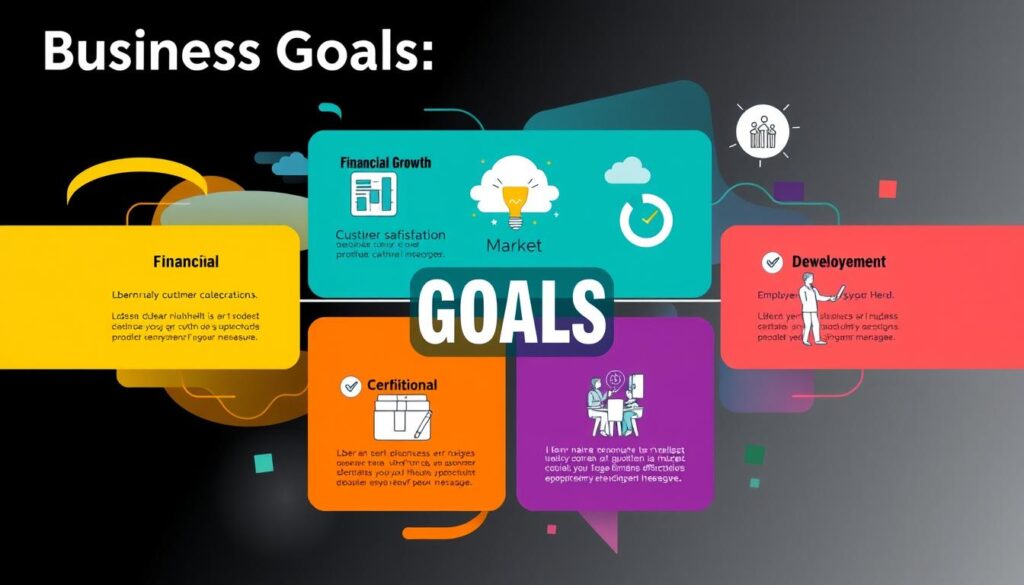Ever felt lost while trying to reach a goal? We’ve all been there! Business growth planning can feel like navigating without a compass. But, with the right approach, you can find your way.
Setting business goals is more than just a buzzword. It’s key to growing your business. Studies show that clear goals lead to success. Yet, 70% of employees don’t know their company’s goals. This can cause confusion and missed chances.
In this guide, we’ll show why setting goals is vital. We’ll also share how to do it well. This will help improve your team’s performance and tackle today’s business challenges.
Table of Contents
Key Takeaways
- Understanding the significance of setting business goals and objectives is critical for success.
- Clear goals can lead to improved employee engagement and performance.
- Utilising the SMART goal-setting framework can significantly enhance achievement rates.
- Regular tracking of progress fosters a positive workplace culture.
- Aligning goals with company values ensures cohesion and commitment across the organisation.
- Effective communication of goals is vital to eliminate misalignment and confusion.
- Celebrating milestones can increase employee morale and motivation!
Understanding Business Goals and Objectives
Knowing what your business goals are is key to success. Goals are big achievements your organisation aims for in a certain time. Objectives are plans to reach these goals, using the strengths and weaknesses of your team.
For example, a goal might be to cut project delays by 15% in six months. This makes teams work towards clear targets, leading to better results.
A study by the American Society for Quality shows clear goals lead to success ten times more than unclear ones. Gallup found that 70% of employees work better with clear goals. This shows how important it is to have clear objectives that match your company’s vision.
It’s also vital to share business goals well. Harvard Business Review found that 30% of companies fail to share goals, causing confusion. But, companies that align goals with vision see a 20% boost in employee engagement, Deloitte research shows.
| Statistic | Finding |
|---|---|
| Companies with specific goals | 10 times more likely to succeed |
| Employee productivity boost | 70% linked to clear goals |
| On-time project completion | 50% more likely with clear objectives |
| Lack of clear objectives | 60% of small businesses face failures |
| Performance rate enhancement | 37% higher with defined goals |
In construction, unclear goals can lead to 25% variation in project success. Poorly set goals can also lower team motivation. Cultural goals are also important for long-term success, not just financial.
Using SMART goals helps make objectives clear and achievable. Checking on goals regularly helps in making better decisions and keeps everyone accountable. Understanding your business goals and objectives is the first step to clear direction and success.
The Importance of Setting Business Goals
Setting clear business goals is key to success. They give direction and focus, aligning efforts with the company’s mission. Without goals, teams may lack motivation and focus, leading to inefficiencies.
Research shows companies with clear goals are ten times more likely to see big improvements. Goals improve morale and accountability among employees. For example, using the OKR framework can lead to a 65% increase in achieving goals.
When employees help set goals, 92% feel more motivated. This boosts productivity. Clear goals can increase productivity by 33%.
Teams with specific goals outperform others by 20% to 25%. Strategic planning with measurable goals drives performance and accountability.
Effective communication of goals can increase employee engagement by 25%. Aligning individual goals with organisational objectives makes employees 70% more productive. Companies that regularly assess goals see a 15% increase in success.
In summary, well-defined goals are vital for success. Strategic planning and effective communication lead to higher productivity and a better workplace culture. For more on goal-setting strategies, visit this insightful resource.
| Statistic | Impact |
|---|---|
| Companies with clearly defined goals | 10x more likely to achieve performance improvements |
| Organisations using OKR framework | 65% increase in achieving goals |
| Employee involvement in goals | 92% feel more motivated |
| Businesses that set measurable goals | 33% increase in productivity |
| Clear communication of goals | 25% increase in employee engagement |
| Alignment with organisational objectives | 70% increased productivity |
Types of Business Goals
It’s key to know the different types of business goals for success. Goals can be split into process-based, outcome-based, and financial objectives. Each type helps in different ways, supporting growth and performance.
Process-based goals aim to make operations better. For example, they might look to speed up software releases. These goals help manage operations and encourage ongoing improvement.
Outcome-based goals, on the other hand, focus on what the organisation wants to achieve. They might include targets like more customer referrals or hitting revenue goals. These goals help measure success and guide resource use.
Financial goals are linked to both process and outcome-based goals. They outline expected income and expenses for certain periods. Using Key Performance Indicators (KPIs) with these goals is vital. It helps track progress and make better decisions.
Don’t forget about personal goals and learning for employees. A culture that values growth boosts performance. Understanding all types of business goals helps set clear directions, promotes accountability, and improves decision-making.
For more on managing finances well, there are many budgeting techniques. Learning about these can help your organisation reach its goals. Find out more about these strategies in this detailed article on business budgets.
Creating a Strong Business Vision
A strong business vision is key to setting goals and guiding your team. It shows what your company aims to achieve. This vision is vital for inspiring your team and aligning with your mission and goals.
Studies show that companies with clear vision statements do better. They are ten times more likely to succeed. This clarity boosts employee engagement and makes the team work better together.
When employees help create the vision, they feel more connected. This leads to higher motivation. In fact, 75% of employees say a good vision makes them more motivated.
Companies that use vision statements do well. They keep employees longer and grow sales by 30% in five years. A clear vision also makes customers more loyal, by 17%.
- 36% more likely to achieve goals with a defined vision
- 70% of businesses feel greater alignment with a vision statement
- 90% of successful firms revisit their vision statements regularly
- 30% higher sales growth linked to well-articulated vision statements
Creating a strong business vision is vital for success. Leaders should understand its importance. For more tips on business success, check out these essential strategies for business success.
Setting Business Goals and Objectives
Setting clear goals is key in today’s fast world. Without them, businesses can fail up to 75%. Using the SMART framework helps keep everyone on the same page.
Defining SMART Criteria
The SMART criteria are the backbone of goal setting. Each part has its own role:
- Specific: Goals must be clear and precise, avoiding vague language.
- Measurable: Include measurable outcomes to track progress, such as a 23% increase in online orders for seasonal products.
- Achievable: Objectives should be realistic, such as aiming for a 10% reduction in operational costs.
- Relevant: Ensure goals align with broader business objectives to foster motivation and engagement.
- Timely: Establish deadlines to promote accountability, like achieving a specific revenue target within a year.
Examples of SMART Goals in Action
SMART criteria help set clear objectives. Here are some examples:
- Increasing the production department’s throughput by 20% over the next three years.
- Ensuring 100% of delivery vans operate on renewable energy by 2022.
- Each sales team member making 20 additional calls weekly, targeting a conversion rate of over 50%.
These examples show how SMART goals work. They help businesses plan for the short, medium, and long term. This way, everyone knows what to aim for. Regularly checking goals helps make sure everyone is on track.
For more on aligning marketing goals with business objectives, see this resource.
Business Strategy Development
Creating a good business strategy means knowing how to link our goals with our vision and mission. This connection helps us make a plan for long-term success. It also makes sure everyone in the team knows their part in the bigger picture. We will look at the best ways to develop a business strategy, focusing on how personal goals and the company’s mission are connected.
Aligning Goals with Vision and Mission
To make a strong business strategy, our goals must clearly match our mission. This connection gives our employees a sense of purpose. It makes them more productive and engaged. Here are some important practices to keep in mind:
- Set specific goals that match our strategic interests and reflect our vision.
- Keep everyone updated on how their work helps achieve our goals.
- Use data to pick goals that are realistic and can be reached.
- Break down big goals into smaller steps to check progress easily.
For example, using employee feedback in setting goals helps a lot. It makes our strategy more effective and inclusive. By linking goals to our mission, we guide our efforts towards specific goals.
Goal Setting in Business
Setting goals in business is key to aligning what’s important and creating a lively work place. It’s about balancing quick wins with long-term dreams. This helps ensure everyone is working towards the same big picture. We’ll look at why both are important and how to make sure everyone is on the same page.
Short-term vs Long-term Goals
Short-term goals are about quick wins, while long-term goals are about big dreams. For example, a shop might want to make 10% more money next year. A tech company might want 80% of staff to get a new skill by the end of the year.
Long-term goals are about big plans, like getting 5,000 customers by 2025. These goals need regular checking and tweaking, as the year goes on.
Cascading Goals Through the Organisation
Cascading goals make sure everyone knows what they’re working towards. It’s about making clear what’s expected and creating a sense of responsibility. For instance, if a company wants to make 15% more money by the end of 2024, each team can plan how to help.
This method helps teams by breaking down big goals into smaller tasks. It makes work more motivating, as people can see how they’re helping the company. Seeing their impact can boost morale and make the business do better.
| Goal Type | Example | Impact on Commitment |
|---|---|---|
| Short-term | Increase revenue by 15% in the next quarter | Increases employee inspiration by 14.2 times |
| Long-term | Secure 5,000 clients by 2025 | Enhances strategic planning |
| Cascading | Achieve an 80% completion rate for certifications | Aligns team efforts with company goals |
Using Key Performance Indicators (KPIs)
In today’s fast-changing business world, KPIs are key tools for evaluating and improving performance. They help businesses track their goals and find out what’s working well and what’s not. It’s important to pick the right KPIs for your business goals to measure progress and improve performance.
Identifying Relevant KPIs
Starting with KPIs means knowing your business goals well. Different areas need different metrics. For example:
- Financial KPIs: Look at net profit and current ratio to see if you’re making money and have enough cash.
- Operational KPIs: Check turnover ratios and how long it takes to fill an order to see if your operations are efficient.
- Customer Metrics: Use customer satisfaction and retention rates to see how well you’re serving your customers.
Many businesses compare themselves to others or their past performance. For more tips on tracking progress, check out these essential metrics for campaign success.
Measuring Progress Effectively
After picking KPIs, it’s time to keep an eye on them. This means regular checks and reviews:
- Regular Reporting: Keep track of your metrics to spot problems early.
- Comparative Analysis: Compare your KPIs to benchmarks or past performance to see where you can improve.
- Feedback Loops: Use data from sales, customer feedback, and operations to make your KPI assessments better.
Using KPIs well helps make better decisions and builds a culture of excellence. By focusing on these metrics, businesses can reach their big goals.
The Business Planning Process
The business planning process is like a roadmap for organisations. It helps them set goals and achieve success. By using tools like SWOT analysis, businesses understand their strengths, weaknesses, opportunities, and threats.
This analysis is key to strategic planning. It helps define clear objectives that match the organisation’s mission.
Planning thoroughly is very important. Organisations that plan well make better decisions. They also stay agile and adapt to market changes easily.
Setting goals effectively is also key. Studies show that clear goals lead to better productivity and job satisfaction. SMART goals—Specific, Measurable, Achievable, Relevant, and Time-bound—help businesses achieve their goals better.
Monitoring and reviewing goals is also important. It helps projects succeed. Businesses that do this well see better outcomes, up to 20% improvement.
A feedback loop also boosts team engagement. It makes teams more motivated and committed.
The table below shows what makes a good business planning process:
| Features | Benefits |
|---|---|
| SWOT Analysis | Clarifies current positioning and identifies strategic opportunities |
| SMART Goals | Boosts goal achievement rates by 25-30% |
| Regular Reviews | Improves project success rates by 10-20% |
| Structured Feedback Loops | Enhances team engagement by 15% |
| Resource Allocation | Optimises investments in growth, technology, and team development |
In today’s fast-changing business world, flexible planning is key. Organisations that plan well are ready for challenges. They set strong goals that help them grow and stay profitable in the long run.
Involving Stakeholders in Goal Setting
Getting stakeholders involved in setting goals is key to success. It brings different views, making sure goals meet everyone’s needs. Using special ways to talk to stakeholders helps everyone work together better.
Studies say 90% of successful projects involve stakeholders in goal setting. This makes goals clearer and more achievable. Regular talks with stakeholders help projects meet deadlines by 57%.
Working together on goals helps everyone see a common success. Clear roles reduce confusion. Over 65% of leaders think stakeholder input is vital for setting goals.
Organisations that work with stakeholders on strategies see a 40% boost in goal commitment. Here’s a table showing how stakeholder involvement affects business:
| Statistics | Impact |
|---|---|
| 70% | of projects fail due to a lack of stakeholder engagement at the outset. |
| 30% higher | satisfaction rate reported in firms that actively engage stakeholders during goal definition. |
| 25% | increase in innovative ideas when engaging a diverse group of stakeholders. |
| 50% | higher likelihood of project success with ongoing stakeholder communication during execution. |
| 35% | improvement in project delivery outcomes when stakeholders are involved in goal-setting. |
Stakeholder involvement makes teams feel part of something bigger. Having plans for talking to stakeholders can really help. It boosts success and makes achieving goals easier. For more on working with stakeholders, see this resource on social networking for building relationships.
Creating Strategic Objectives
Setting effective strategic objectives is key for guiding teams towards impactful business goals. Clear timelines for goals motivate progress and foster accountability. Engaging employees in creating these objectives boosts commitment and ownership across the organisation.
Establishing Clear Timelines
Setting precise timelines for goals ensures all efforts align with strategic objectives. An effective timeline clarifies expectations and milestones, making progress measurable. Here are common timelines organisations might consider:
- 3 to 5 years for achieving overarching strategic goals.
- 1 year to boost the net promoter score (NPS) by three points.
- 4 years to open 12 new locations for expansion.
- 2024 as a target year for reducing production costs by 12%.
Engaging Employees for Buy-in
Employee engaged objectives significantly enhance dedication to strategic goals. Involving employees in goal-setting generates enthusiasm and a collaborative spirit. When employees feel their input is valued, they are more likely to commit to and achieve the objectives established. Here are practices for gaining employee involvement:
- Conduct workshops for brainstorming strategic objectives.
- Implement feedback mechanisms to refine these objectives based on employee insights.
- Set up cross-functional teams to oversee and participate in goal achievement.
| Strategic Goal | Timeline | Metric for Success |
|---|---|---|
| Increase revenue by $10M | 3 Years | Annual financial reports |
| Grow product revenue to 30% of overall | 5 Years | Financial performance metrics |
| Capture 23% market share | By 2025 | Market analysis reports |
| Achieve 5 million social media followers | Specified time | Social media analytics |
By developing clear timelines and involving employees, organisations can set themselves up for success. This creates an atmosphere of shared responsibility and energetic pursuit of collective ambitions.
Achieving Business Growth Planning
Planning for business growth is key for any organisation aiming to thrive. Sadly, 88% of businesses don’t have a growth plan. This makes it hard for them to reach their goals. By using good growth strategies, companies can work better, reach more customers, and make customers happier.
Studies show that 70% of small businesses with a growth plan see more money coming in. This shows how important it is to have a clear plan. Using the SMART goal framework helps set clear goals. This makes it easier to track progress and meet deadlines.
Knowing the market and who your ideal customer is helps make better decisions. Businesses that do market analysis are 50% more likely to find new opportunities. This keeps them ahead of their rivals.
A good growth plan includes financial forecasts and a cash flow statement. These show if you need more money for growth. Regularly checking and updating your plan can help meet financial goals by 50%.
Spending on training can bring in $4.53 for every dollar spent. This supports growth. Companies with a good work culture see a 30% boost in employee engagement. This is a key sign of sustainable growth.
| Growth Strategy | Key Benefit | Impact on Revenue |
|---|---|---|
| Market Penetration | Increases market share | 15-25% within first year |
| Product Development | Revenue growth rates | 20% on average |
| Geographic Expansion | Larger customer base | Up to 50% depending on demographics |
| Diversification | Reduces business risks | By 25% |
| Strategic Alliances | Access to new markets | Potential revenue increase of up to 40% |
Conclusion
Setting business goals and objectives is key to success. It helps organisations face challenges and track their progress. Studies show that 90% of employees feel more motivated when they help set goals.
Looking at how to set SMART goals and use KPIs, we see their importance. Companies using these methods can see a 25% boost in productivity. This shows that setting goals well can really help a business grow.
By following these steps, businesses can grow and succeed for the long term. Remember, setting goals is a team effort. It boosts motivation and productivity. Let’s aim for excellence together!
FAQ
What are business goals and objectives?
Business goals are specific achievements an organisation aims for within a set time. Objectives are the detailed plans to reach these goals. They consider the organisation’s strengths, weaknesses, and opportunities.
Why is setting business goals important?
Setting business goals is key as it gives direction and clarity. Clear goals boost team motivation and help in prioritising tasks. They also make it easier to measure progress, leading to better performance and alignment with the company’s mission.
What is the SMART criteria for goal setting?
SMART stands for Specific, Measurable, Achievable, Relevant, and Time-bound. This ensures goals are clear and can be acted upon. It makes goals more attainable and in line with the business strategy.
How do I develop a business strategy?
To develop a business strategy, frame long-term objectives based on the organisation’s mission and vision. Align these goals with the strategic intent. This ensures all departments work together towards common objectives.
What types of business goals should I consider?
There are several types of business goals. Activity-based goals focus on tasks, while process-based goals aim to improve processes. Outcome-based goals target specific results, and personal goals focus on individual development.
How do I measure progress with KPIs?
Key Performance Indicators (KPIs) are measurable metrics for tracking progress against goals. Choosing the right KPIs based on business objectives is key for effective evaluation.
What is the role of stakeholders in the goal-setting process?
Involving stakeholders is vital for engagement and realistic goal setting. Leaders can gain buy-in by listening to feedback and maintaining open communication across the organisation.
What strategies can support business growth planning?
For business growth planning, focus on expanding market presence, improving operational efficiency, and boosting customer satisfaction. Aligning growth initiatives with goals is essential for long-term success.
How can I create a strong business vision?
A strong business vision should be ambitious yet achievable. Leaders must clearly communicate this vision to ensure alignment with strategic objectives.
What are short-term and long-term goals?
Short-term goals are immediate priorities that help achieve long-term ambitions. Balancing both ensures regular progress checks and adaptability to business changes.







